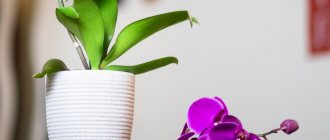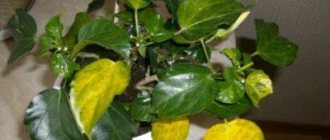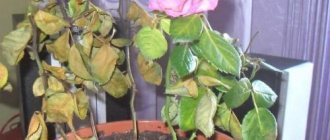What kind of plant is this?
Impatiens is a genus of perennial or annual herbaceous plants of the Balsamaceae family. Their homeland is considered to be the subtropics and tropics of Asia and Africa, East Africa and Zanzibar. some species can be found in Central Asia. The plant has erect leaves, the stem height reaches 50 centimeters.
The leaves are lanceolate or oval in shape and can reach 8-12 centimeters in length. The original color of balsam is red or pink , but at the moment breeders have bred flowers with petals of a different color, except yellow and blue. After flowering, green fruits are formed, after ripening they form a dry capsule.
The fruit has an oblong shape. 1 gram of bud can contain up to 100 seeds. The name of the genus includes the name “impatiens”, which means sensitive, intolerant of pressure.
IMPORTANT : The name fully reflects the nature of the dry capsule; with any touch, the plant “shoots” the seeds at a distance of up to 2 meters. For this property, people call it “Touch-me-not”; the balsams themselves are easy to care for, resistant to dry air, grow well, and are not particularly demanding of heat.
Why does balsam drop its buds?
The genus Impatiens includes over 500 species of annual and perennial herbaceous plants of the balsam family. Its homeland is the tropics and subtropics of Asia and Africa; some species are found in Central Asia.
Thanks to its long-blooming beautiful flowers and unpretentiousness, balsam has long been popular as a houseplant. Currently, the flower is widely used for growing in open ground, decorating front gardens, flower beds, flower beds and borders with its large flowers. If all requirements for planting and care are met, balsam can be grown from seeds and you can admire its flowering for a long time.
Structural features
The main features include the second popular name of the flower – “weather forecaster”. Due to the extremely sensitive flowers, the plant senses changes in the atmosphere very well , which helps the owner of the balsam determine the weather.
An example is that before the rain, droplets appear on the stems, twigs and leaves, which are a sugar substance that crystallizes in the fresh air. So, by having such a plant at home, you will acquire an infallible weather forecaster.
Transfer
Impatiens have a rapid growth and development rate, so it requires annual replanting. It is produced during the period when the plant has not gained color. It is best to replant in spring or summer. It is not replanted during the winter dormancy period. In order to properly transplant an indoor flower, you need to follow these recommendations :
- Water the pot in the pot generously to make it easier to remove.
- Choose a pot with a diameter larger than the old one by 5-6 cm .
- Prepare a fresh composition of fertile soil .
- Remove the plant from the pot , clean it, and rinse the roots from the soil. If necessary, remove old and rotten areas.
When transplanting New Guinea balsam, you need to fill the prepared pot with drainage to a quarter of its entire volume.
- Place the plant in a new pot, cover it with soil and compact it slightly.
- Water the plant thoroughly at room temperature.
Possible reasons
Why does balsam shed buds and flowers? After all, all sources say that balsam is not the most whimsical plant. Despite the integrity of the entire plant, the buds are the most unprotected part of the plant .
It is often very difficult to determine the problem that causes buds to fall off, but the following reasons often lead to this problem:
- pests such as mites and tripe;
- irregular watering;
- incorrectly selected soil, since balsam is extremely harmful to the acidity level; if it does not match, the plant begins to die;
- excessively dry air.
Stunted impatiens, or why impatiens buds and flowers fall off: we solve the problem in a timely manner
Impatiens is a fairly harmless and common plant. It has about 500 species. However, despite all this simplicity and prevalence, balsam has special buds that combine beauty, tenderness and extreme whimsicality.
Beginning flower growers often encounter a number of problems, which will be discussed in detail below, and methods of combating and preventing all problems will also be indicated. Look further for the answer to the question: “Why do balsam buds fall off?”
We treat the “touchy”
To save your plant, you need to immediately take measures related to creating the necessary living conditions for the plant:
- First, you need to set a certain air temperature in the room. The ideal temperature range is 12-14 degrees Celsius.
- Next comes humidity, there is nothing difficult with it, ordinary room humidity is suitable for balsam, the main thing is not to dry the air too much.
- With watering, everything is much more complicated.
Impatiens is a fairly moisture-loving plant that has succulent, moisture-filled stems. Of course, if watering is not sufficient, the plant will not wither, but its leaves will lose their elasticity, and the lower ones may even fall off. Watering must be observed as follows: in summer, abundant watering, almost all the ground should be moist. In winter, watering is reduced. Do not overdo it with watering through the pan; an excess of water in it leads to rotting of the root system.
Impatiens need to be fed with mineral fertilizers every two weeks. Again, don't overdo it. For example, an excess of nitrogen fertilizers can enhance stem growth, while at the same time it will slow down flower growth.- Don’t forget about replanting a freshly purchased plant. It is worth choosing a pot that is small, according to the size of the root system, since if the pot is much larger, flowering may be delayed. At the same time, plants grown from cuttings should not be replanted.
- You don’t have to bother with the soil, since balsams are unpretentious to the soil.
Diseases of balsam include the appearance of various pests, such as aphids, whiteflies and spider mites (read about how to deal with spider mites on balsam here). Insecticides will help you against pests . Prevention: avoid rotting of the soil, and also prevent drying out the air.
Read more about diseases and pests of balsam, as well as how to cure the plant, in our material.
Home care
Humidity and watering
New Guinea balsam is an unpretentious flower, but if it is not properly cared for, it may stop blooming or die completely. With proper care, the plant will delight you with its flowers all year round . The main requirements include humidity and watering. Watering should be done regularly and abundantly.
The optimal humidity is 50%. In hot weather, you need to water daily to prevent the soil from drying out. In winter, watering should be reduced to 2 times a week . Do not allow the air to become too dry; flowers may fall off. To increase humidity, it is recommended to spray the plant with warm water, especially in winter. You can also increase the humidity by placing the pot on a tray with expanded clay, into which water is poured.
Consequences of not solving the problem in a timely manner
The main consequences include the above-mentioned appearance of parasites. But improper care and maintenance conditions can also lead to illness and death of the flower.
- At low temperatures and at the same time an excess of moisture, the leaves may turn yellow and fall off, a gray fluffy coating may appear (read about why balsam leaves fall off and how to help the plant, and from this article you will learn why the leaves of an indoor flower turn yellow ). This type of plaque is called “Grey Rot”.
- Under the same conditions, but with increased temperature, the leaves will simply droop. Simply lowering the temperature will help.
- If there is excess moisture due to tray irrigation, the root system may begin to rot.
- Buds and flowers may fall off due to dry air and high temperatures.
- In the absence of nutrients and lack of light, the stems begin to stretch, and the flowers, on the contrary, become small and dry.
ATTENTION : With all of the above causes of disease, the following problems may arise: petals fly away, leaves turn pink and become stained, lack of flowering, the number of flowering buds becomes smaller, and so on.
Read about why indoor balsam does not bloom, but only leaves grow, here.
Reproduction methods
New Guinea balsam can be propagated by seed and cuttings . In early spring or early summer, shoots 10 cm long are cut from the main bush. They are planted in prepared pots with a mixture of peat and sand. The top of the cuttings is covered with film and watered abundantly. After 2 weeks, when they take root, the film should be removed.
Seed propagation is carried out in several stages:
- Soak the seeds in warm water for several hours.
- to sow in March, in peat soil.
- The seeds are mixed with sand .
- Watering should be done using a spray bottle so as not to wash out the seeds.
- Cover the top of the boxes .
- Provide a well-lit place with a temperature of at least 20 degrees.
- After 2-3 weeks , when the first shoots appear, the film should be removed.
- When the seedlings reach 5 cm , they are transplanted into separate containers.
When propagating New Guinea balsam by seeds, you will not be able to retain the characteristics of the mother plant
When propagated by seed, the plant can bloom within 3 months .
Preventive measures
Basic preventive measures include normalizing temperature, soil moisture, dry air and normalizing soil acidity. In addition, when pests appear, it is worth using insecticides .
Feeding can help, the main thing is not to overdo it, because you can make it even worse. Avoid sudden changes in temperature, and do not turn an already flowering plant. In winter, you should not place it near a north window.
In conclusion, I would like to say that balsam, despite the difficulties with caring for the buds, is a very beautiful and useful plant that will appeal to both beginning gardeners and experienced gardeners.
Also, do not forget about 500 different varieties, each of which has its own unique coloring and modified conditions. for example, some balsams are resistant to dry air, but at the same time more demanding of watering. In general, the choice remains with the gardener.
Chapter 1. What to do if balsam begins to drop buds
Most often, the reasons for the weakening of a green pet, its withering or cessation of growth are failure to comply with the required conditions of maintenance or lack of attention. In nature, balsams live in regions with a warm, fairly humid climate, where there are no sudden changes in temperature and, especially, frost.
Asking the question: “Why do balsam buds fall off?”, the florist must analyze the conditions in which the flower is located. Operating heating devices affect both the room temperature and air humidity. The lower it is, the stronger the evaporation of moisture from the leaves, and the balsam weakens faster. This is also caused by frequent drying out of the soil, especially during active growth.











